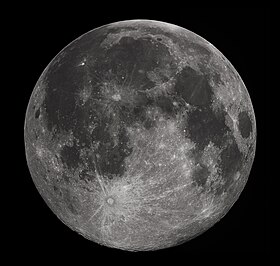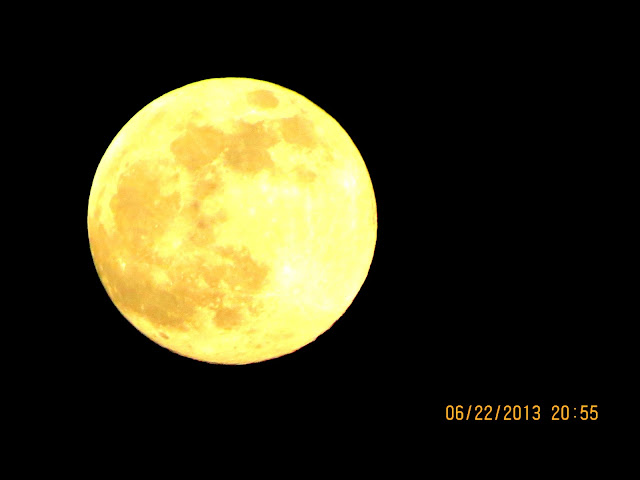Hi Everybody!!
Of course, I shot the Super Moon for You! Look how huge it is. I could not get the whole moon in the frame on my zoom! I went out several times (until 4am) to get different shots of how the Super Moon matured into the night. The frogs and crickets on the creek were singing loudly as the full moon light must excite them. Anyway, how wonderful to stand in the middle of the woods in the middle of the night and behold such beauty and peace. I share this feeling with All of You. Enjoy Your Super Moon!
http://en.wikipedia.org/wiki/Supermoon
Supermoon
From Wikipedia, the free encyclopedia
A supermoon is the coincidence of a full moon or a new moon with the closest approach the Moon makes to the Earth on its elliptical orbit, resulting in the largest apparent size of the moon's disk as seen from Earth. The technical name is the perigee-syzygy of the Earth-Moon-Sun system. The term "supermoon" is notastronomical, but originated in modern astrology.[1] The association of the Moon with both oceanic and crustal tides has led to claims that the supermoon phenomenon may be associated with increased risk of events such as earthquakes and volcanic eruptions. However, the evidence of such a link is widely held to be unconvincing. [2]
The next occurrence is on June 23, 2013. This full moon will be the closest and largest full moon of the year. It also presents the moon’s closest encounter with Earth for all of 2013. The moon will not be so close again until August 10, 2014.[3]
They occur about once every 14 full moons in a full moon cycle.
Definition[edit]
The Moon's distance varies each month between approximately 357,000 kilometers (222,000 mi) and 406,000 km (252,000 mi) due to its elliptical orbit around the Earth (distances given are center-to-center).[4][5][6]
According to NASA, a full moon at perigee is up to 14% larger and 30% brighter than one at its farthest point, or apogee.[7]
Terminology[edit]
The name SuperMoon was coined by astrologer Richard Nolle in 1979, arbitrarily defined as:
The term supermoon is not used within the astronomical community, which use the term perigee-syzygy or perigee moon.[9] Perigee is the point at which the Moon is closest in its orbit to the Earth, and syzygy is a full ornew moon, when the Earth, the Moon and the Sun are aligned. Hence, a supermoon can be regarded as a combination of the two, although they do not perfectly coincide each time. On average, about once a year the moon becomes full within a few hours of perigee.[9]
Effect on tides[edit]
The combined effect of the Sun and Moon on the Earth's oceans, the tide,[10] is greatest when the Moon is eithernew or full.[11] At lunar perigee the tidal force is somewhat stronger,[12] resulting in perigean spring tides. But even at its most powerful this force is still relatively weak[5] causing tidal differences of inches at most.[13]
As the tidal force follows an inverse-cube law, that force is 18% greater than average. However, because the actualamplitude of tides varies around the world, this may not translate into a direct effect.
It has been claimed that the supermoon of March 19, 2011 was responsible for the grounding of five ships in the Solent in the UK,[14] but such claims are not supported by scientific evidence.
http://en.wikipedia.org/wiki/Moon
 Full moon as seen from Earth's northern hemisphere | |||||||||||||
| Designations | |||||||||||||
|---|---|---|---|---|---|---|---|---|---|---|---|---|---|
| Adjective | lunar, selenic | ||||||||||||
| Orbital characteristics | |||||||||||||
| Perigee | 362,570 km (0.0024 AU) | ||||||||||||
| Apogee | 405,410 km (0.0027 AU) | ||||||||||||
| Semi-major axis | 384,399 km (0.00257 AU)[1] | ||||||||||||
| Eccentricity | 0.0549[1] | ||||||||||||
| Orbital period | 27.321582 d (27 d 7 h 43.1 min[1]) | ||||||||||||
| Synodic period | 29.530589 d (29 d 12 h 44 min 2.9 s) | ||||||||||||
| Average orbital speed | 1.022 km/s | ||||||||||||
| Inclination | 5.145° to the ecliptic[2] (between 18.29° and 28.58° to Earth's equator)[1] | ||||||||||||
| Longitude of ascending node | regressing by one revolution in 18.6 years | ||||||||||||
| Argument of perigee | progressing by one revolution in 8.85 years | ||||||||||||
| Satellite of | Earth | ||||||||||||
| Physical characteristics | |||||||||||||
| Mean radius | 1,737.10 km (0.273 Earths)[1][3] | ||||||||||||
| Equatorialradius | 1,738.14 km (0.273 Earths)[3] | ||||||||||||
| Polar radius | 1,735.97 km (0.273 Earths)[3] | ||||||||||||
| Flattening | 0.00125 | ||||||||||||
| Circumference | 10,921 km (equatorial) | ||||||||||||
| Surface area | 3.793 × 107 km2 (0.074 Earths) | ||||||||||||
| Volume | 2.1958 × 1010 km3 (0.020 Earths) | ||||||||||||
| Mass | 7.3477 × 1022 kg (0.012300 Earths[1]) | ||||||||||||
| Mean density | 3.3464 g/cm3[1] | ||||||||||||
| Equatorial surface gravity | 1.622 m/s2 (0.165 4 g) | ||||||||||||
| Escape velocity | 2.38 km/s | ||||||||||||
| Sidereal rotation period | 27.321582 d (synchronous) | ||||||||||||
| Equatorial rotation velocity | 4.627 m/s | ||||||||||||
| Axial tilt | 1.5424° (to ecliptic) 6.687° (to orbit plane)[2] | ||||||||||||
| Albedo | 0.136[4] | ||||||||||||
| |||||||||||||
| Apparent magnitude | −2.5 to −12.9[a] −12.74 (mean full moon)[3] | ||||||||||||
| Angular diameter | 29.3 to 34.1 arcminutes[3][b] | ||||||||||||
| Atmosphere[6] | |||||||||||||
| Surfacepressure | 10−7 Pa (day) 10−10 Pa (night)[c] | ||||||||||||
| Composition | Ar, He, Na, K, H, Rn | ||||||||||||
This is the last series at 4 am!
...this is brendasue signing off from Rainbow Creek. See You next time! I put a kiss on the Moon for all of You!!! Have a good week!
O+O



























































No comments:
Post a Comment
Hi Everybody! Please say hello and follow so I know you are here! Due to the inconsideration of people trying to put commercials on my blog comment area, I have restricted use of anonymous posts. Sorry that some hurt all.
My public email is katescabin@gmail.com No spammers or trolls